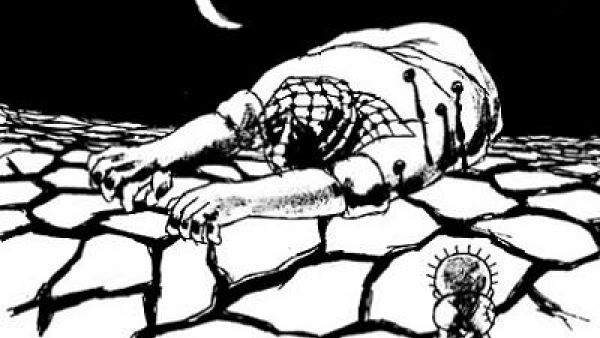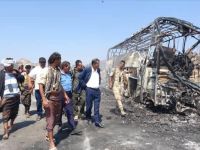ALBAWABA - Today the Arab world remembers the well-known Palestinian cartoonist Naji Al Ali. It has been 35 years since he died on 29 August, 1987. Al Ali was shot in the head by a gunman outside the offices of the Kuwaiti Al Qabas newspaper in London on 22 July of that year and he never recovered going into a coma till the fateful date of his death.
ريشة ناجي العلي: أقوى من الاستسلام والموت
— Bashar Hamdan (@Bashar_Hamdan) August 30, 2022
*بريشة الفنان الفلسطيني غازي انعيم، ١٩٨٧ - من أرشيف ملصق فلسطين pic.twitter.com/rqspo4svB0
Today, as well Arabs remembers his death with the social media full of commentary about his existence, reprints of Hanthala, the famous Palestinian boy character who always had his back to the world, which was a sort of symbolism about the world forgetting what happened to the Palestinians.
يوم اغتيل #حنظلة.#ناجي_العلي pic.twitter.com/1D1tlKKsEI
— Hameed Nassereldeen (@HNassereldeen) August 30, 2022
By contrast Hanthala had a sense of defiance with the camp boy turning his back unto the world.
وأنا أيضًا أنتمي للوطن لا للدكاكين السياسية#ناجي_العلي يمثلني pic.twitter.com/u6mjIq5a9X
— #birow (@AbeerSTahboub) August 30, 2022
By the time he was killed Al Ali had drawn 40,000 cartoons, expressing a sense of rebelliousness against the Arab dominant status quo of not fighting for Palestine, his refugees status and the thousands upon thousands of others who were forced out of their country and dispersed into the Arab world, to Jordan, Lebanon, Syria, Egypt, the Gulf countries and around the globe.
في ذكرى رحيله 35.. رواد مواقع التواصل الاجتماعي يكتبون "عاش حنظلة واستشهد ناجي العلي" ..الرسام الفلسطيني الذي قاوم الاحتلال بريشته ..تابع التفاصيل ?pic.twitter.com/f5GFcuKDT8
— عربي21 (@Arabi21News) August 30, 2022
Al Ali saw his drawings as a form of political struggle, to fight for Palestine, weaving politics, culture and society together and carefully articulating distinct messages against injustice, oppression, underdevelopment and fight for democracy in the Arab world.
#الكاريكاتير
— ناجي العلي وولده حنظله (@NHnzlh) August 30, 2022
تعرية الحياة بكل معنى الكلمةفينشرها دائماً على الحبال وفي الهواء الطلق وفي الشوارع العامة
إنه يقبض على الحياة أينما وجدها لينقلها إلى أسطح الدنياحيث لا مجال لترميم فجواتها
ولا مجال لتستير عوراتها
هذا الفن يجب أن يكون عدوانياًفي موضوعاته
على وجه الخصوص
ناجي العلي pic.twitter.com/ntFQJDOFDe
He and his family were expelled from Palestine in 1948 to Lebanon, ending up in the Ain Al Hilweh camp and was 10 or 11 years old at the time. His village was called Shajara in Palestine but it was totally destroyed then along with 400 other villages by Israeli gangs who had no compunction about killing men, women, children old and young and when they did that at what become known as the Dir Yassin massacre.
قتلت ناجي العلي لما رسم صورة
— ناجي العلي وولده حنظله (@NHnzlh) August 30, 2022
يواجه الحزن فيها براية مكسورة
لما فضحني ورسمني صورة طبق الأصل
ما عرفشي يكذب ...ولا يطلع قليل الأصل
الناس بترسم بريشة ... وهوه ماسك نصل
#الأبنودي pic.twitter.com/KrkXFfqS9T
It is this bloody history that came into his cartoons, a representation of a whole population that was unjustly dealt with. But it was his passion for politics and cartoon drawings that was itched on his mind. In the 1950s he went to Kuwait, like many at the time who were searching for jobs, spent a stint in Lebanese prisons were he draw more cartoon on its walls, worked in Kuwait and expelled from there where Al Qabas sent him to draw in her London office in 1985 and where he met his deadly fate two years later.
"اللي بدو يكتب عن #فلسطين، واللي بدو يرسم لفلسطين بدو يعرف حاله ميت، أنا مش ممكن أتخلى عن مبادئي ولو على قطع رقبتي".
— ناجي العلي وولده حنظله (@NHnzlh) August 30, 2022
ناجي العلي pic.twitter.com/CJPDaqfHdV
"I felt within me a need for a different medium to express what I was going through," he used to say. He often said he felt it was harder to censor a cartoon than an article. Al Ali's talent was first discovered by Ghassan Kanafani, the Palestinian writer and activist killed by the Israelis in the early 1970s. He was visiting the camp at the time, came upon Al Ali's work, took a sample and latter published them in Al Hurriya, the magazine he was working for Marwan Asmar wrote in Gulf News.
في ذكرى رحيله.. هل تورط محمود درويش في اغتيال #ناجي_العلي ؟ pic.twitter.com/rVySjSrwZn
— بوابة فيتو (@Vetogate) August 30, 2022
Throughout the years also worked for the weekly Al Talieha magazine in Kuwait, and for the Lebanese Al Saffir before moving on again to Al Qabas Arabic daily. Despite his death he will continue to be remembered and honored in the Palestinian popular framework and among the Arab man in the street.
يعرّف حاله: "اسمي ناجي العلي، ولدت حيث ولد المسيح، بين طبرية والناصرة في قرية الشجرة بالجليل، أخرجوني من هناك بعد عشر سنوات في 1948 إلى مخيم عين الحلوة في لبنان أذكر هذه السنوات العشر أكثر مما أذكره من بقية عمري، أعرف العشب والحجر والظل والنور، لا تزال ثابتة في محجر العين pic.twitter.com/wt4E2m5BU2
— ناجي العلي وولده حنظله (@NHnzlh) August 30, 2022
He has murdered but his Hanthala will continue to live on. In a perceptive sense he used to say the cartoon character will outlive him. The name of Hanthala means bitterness in Arabic. It represents the aspirations of the camp refugees and the longing for the right of return to the villages, towns and cities of Palestine.
#ناجي #العلى رسمها قبل اطلاق الرصاص عليه في 22-7-1987 والانتفاضة اشتعلت في 8-12-1987 pic.twitter.com/YM13WJr06u
— ناجي العلي وولده حنظله (@NHnzlh) August 30, 2022
He always has his back to the readers and will only turn his head when Palestine is freed from occupation and thus Hanthala will remain a 10-year -old till that dream comes true.







